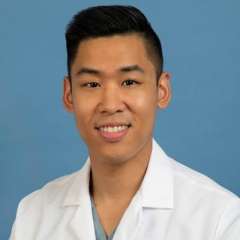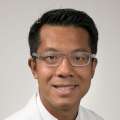As our nation celebrates this month the history and contributions of Asian Americans and Pacific Islanders, three UCLA Health physicians of Asian descent — Albert Chang, MD, PhD; Alan Lee, MD; and Puja Venkat, MD — are striving to make their mark on the present.
Led by Dr. Chang, associate professor and vice chair of surgical services and brachytherapy service chief for the Department of Radiation Oncology, this highly skilled team performs a specialized procedure called high-dose rate (HDR) brachytherapy.
The procedure involves inserting radioactive material inside the body, rather than the traditional method of projecting it from a machine outside the body, which allows doctors to deliver higher doses of radiation to specific areas. This type of image-guided, targeted radiation is highly effective in treating cancers of the prostate, head and neck, breast, cervix and eye. In addition, the UCLA brachytherapy team is the only center in the United States to perform the highly effective and safe brachytherapy procedures for cancers in the lung, mediastinum, liver and abdomen.
Dr. Chang has performed more than 2,000 brachytherapy procedures.

Dr. Venkat first learned of brachytherapy during medical school while treating a young woman with cervical cancer in rural Guatemala. “She came back to the U.S. with us for treatment, which consisted of concurrent chemotherapy and radiation followed by brachytherapy. This was an area of medicine I was completely unfamiliar with. Through this experience, I learned about the enormous loss created by cervical cancer all over the world.”
She notes that the lack in the U.S. of resources, training and reimbursement for brachytherapy greatly hinders the ability of women to obtain high-quality, curative treatment for cervical cancer. “Part of our mission at UCLA is to re-excite the medical world about what brachytherapy can offer,” Dr. Venkat says.
In addition to their clinical work, the three physicians are striving to shine a light on diversity and inclusion within their department and to promote equity in medical care within the community.
Fostering understanding
Roughly 17% of active physicians identify as Asian American while comprising less than 7% of the overall population. Within UCLA Health, Asians make up 25.4% of UCLA Health Hospital System employees, 35.4% of David Geffen School of Medicine at UCLA employees and 27.5% of all UCLA Health employees, while comprising 14.5% of the Los Angeles County population.
Despite a rise in hate crimes and anti-Asian sentiment since the pandemic began, Drs. Chang, Lee and Venkat say they have not encountered racism at UCLA or within their communities.
“For better or worse, we’re insulated in a bubble here where people are fairly culturally aware,” says Dr. Lee. “Most of the racism I experience is through my friends who live elsewhere. I’ve had some reach out to me for advice. ”
Still, there is always room to grow in cross-cultural understanding, Dr. Venkat says. “I think too often we focus on the science and forget the humanity of medicine, and that’s part of what our department is trying to change as we move forward.

“Everything that’s happening in society right now are daily reminders of inequality and injustice out there,” she says. “We have a duty to acknowledge what’s happening out in our community and find ways to impact beyond our bubble.”
To that end, the Radiation Oncology department has launched an equity, diversity and inclusion committee, which Dr. Venkat co-chairs. The goal is to have departmentwide meetings every two months, during which participants read literature, listen to podcasts and watch movies about racism in America.
“In between sessions we’re trying to create a constant dialogue about things that happen in the media,” she says. For example, for Asian American and Pacific Islander Heritage Month in May the group discussed the Japanese internment camps. “Where I grew up, we didn’t talk about internment camps — it was just a one-liner during World War II history. But a lot of the team here has a very close history to that awful time that we’ve suppressed.”
After that session, several team members came to her expressing gratitude for the topic and having a safe place to talk about these types of issues, Dr. Venkat says. “So that’s an important project for me moving forward.”
Finding their calling
Although each of the three physicians chose a career in medicine, their paths to UCLA Health were varied. Dr. Chang is of Chinese descent, his father hailing from Shanghai and his mother from Hong Kong. He grew up in San Francisco, a diverse city where he blended in among a variety of cultures and ethnicities. His parents were accountants, and Dr. Chang excelled in math and the sciences, which for him became a bridge to medicine.
“My parents didn’t make a lot of money, but they valued education and the way they set a high importance influenced me,” Dr. Chang says. “They put me in whatever opportunity they could to help me to succeed, so I think that made a big difference in my career.”
Dr. Chang received his PhD in molecular medicine and MD from the Boston University School of Medicine. He completed his residency at the Washington University School of Medicine in St. Louis and then joined the faculty at UCSF as an assistant professor, before landing at UCLA Health.
He was named among Los Angeles Magazine’s Top Doctors in 2021 and is a recognized leader in his field. His interest in research and teaching is evident as he is the principal investigator of multiple clinical trials studying the combination of radiation therapy and immunotherapy and also on the national radiation oncology examining board.

In contrast, Dr. Lee and Dr. Venkat grew up in the Midwest — Kansas and Michigan, respectively — and were members of the lone Asian families in their communities during much of their early schooling. “It was challenging to be the only Asian person, but I think it also allowed me to embrace other people’s cultures because I know what it feels like to be excluded,” says Dr. Lee, whose parents immigrated from Taiwan before he was born.
Dr. Lee spent his high school years in Taiwan, where he identified with the designation as a “third culture kid — not really American, not really Taiwanese,” he says. “It was lonely.” His family stressed education and a strong work ethic, which helped shape his future in medicine, he says.
After graduating from the University of Kansas, he pursued other interests before deciding to go to medical school at SUNY Upstate Medical University in Syracuse, N.Y. He was drawn to brachytherapy because of the procedural aspect of it, he says. “I like working with my hands.”
Growing up, Dr. Venkat experienced a cultural duality in which her interactions within her traditional Indian family were at odds with her social interactions outside the home, she says. Coming from a family of doctors, medicine was something she had considered but didn’t want to pursue just because it was expected of her.
She majored in English at Stanford University and took classes in archaeology, Latin American studies, and economics — “The most different things I could think of from medicine,” she recalls. After graduation, she worked in Bangladesh for a nongovernmental organization focused on education. It was during her work at a hospital there she realized the immediate impact she could make on people’s lives through medicine.
“That experience pushed me to do what I always intended to do and go to medical school,” Dr. Venkat says. She finished her pre-med requirements, took the Medical College Admission Test (MCAT) and then took a two-year break before entering the University of Toledo College of Medicine.
“Since I had that break, I felt like medicine wasn’t a path that was chosen for me; I chose it,” says Dr. Venkat, who also was named among Los Angeles Magazine’s Top Doctors in 2021
Removing barriers
Dr. Lee notes that as physicians, and as minorities, he and his colleagues have unique opportunities to champion equity, diversity and inclusion, which includes breaking down cultural barriers to treatment.
Language difficulties, lack of access to health care or insurance, and indifference are some of the barriers that prevent non-English-speaking patients from getting proper medical care, he says.
“The first threshold for access to cancer screening and prevention is the primary care physician, getting screened for lung cancer, a CT scan, pap smear or a colonoscopy,” Dr. Lee says. “A lot of patients present with advanced cervical cancer due to of lack of access or some simply don’t know they’re supposed to routinely see doctors.”
Dr. Venkat agrees language barriers prevent many patients from accessing services, even with a translation service available via iPads in clinical and procedural rooms.
She tells the story of a cervical cancer patient who could benefit from physical therapy, but refuses to go to appointments without her husband to translate.
“This would be one-on-one physical therapy,” Dr. Venkat explains. “I’ve been encouraging her to give it a shot, but when you’re talking about sensitive areas through an iPad with somebody who is not part of your treatment team, it’s a real barrier.”
Dr. Venkat is looking at how her department can encourage clinical trial enrollment by translating the protocols and consent process into multiple languages to promote equity in the process.
“Are we enrolling non-Caucasian patients in clinical trials and what are the numbers on that? We know there’s a big disparity in that, and we’d like to know what we can do to improve those numbers,” she says.
Dr. Chang’s team plans to publish a paper aimed at non-Caucasian patients explaining brachytherapy and its benefits. They’re also working on a vaginal health study, part of which looks at outcomes by race to discover any nuances post-radiation.
The goal is to promote better dialogue with all patients, Dr. Venkat says.
“Having patient access to our care is very important and so is being able to get out into the community to make sure people are aware of our services,” Dr. Chang says. “I think it takes educating not just our students and our trainees, but our public as well.”
Learn more about UCLA Health's radiation oncology research and patient services.
Jennifer Karmarkar is the author of this article.






